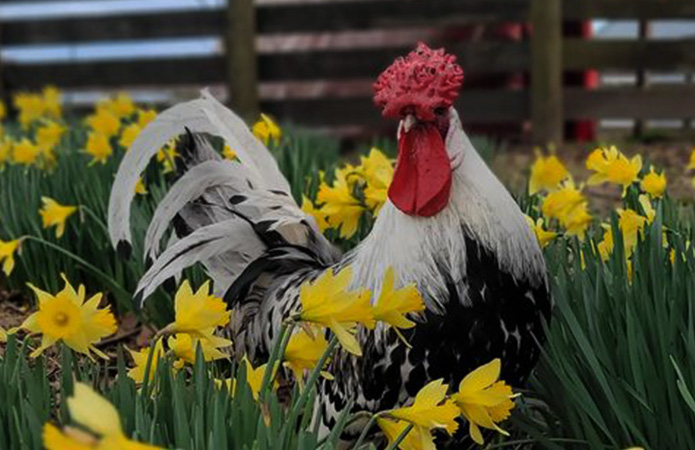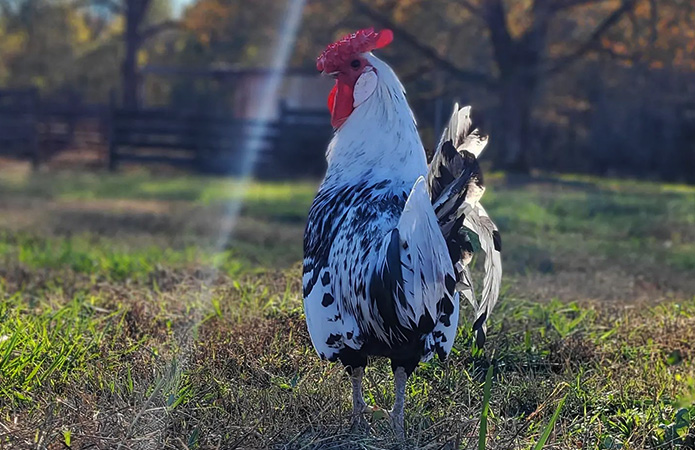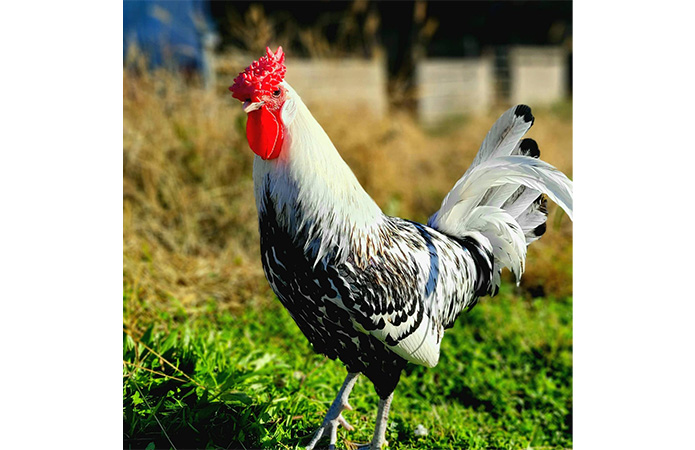Hamburg Chicken: All About This Rare Breed

The Hamburg chicken is a dazzling beauty that can be a great addition to any backyard flock. Their striking colors and plumage will captivate everybody, as the Spangled Silver color is found exclusively in this breed. They’re also great egg layers and excellent foragers.
- Hamburg hens lay up to 4 eggs weekly
- Heritage breed, considered rare and threatened
- Very active and flighty
- Silver Spangled is the most common and popular color
| Eggs | Between 200-250 eggs/year |
| Egg Color | White |
| Egg Size | Small to medium |
| Weight | 3.5 – 5.5 lbs |
| Hardiness | Cold & Heat |
| Temperament | Flighty, active |
| Beginner-friendly | Yes, but they need plenty of space |
| Color | Six recognized colors in the US |
Characteristics
The Hamburg chicken has a profound appearance, and because of that, while looking at them, you would feel star-struck. They are ornamental birds that are also exceptional layers.
They have striking red bay eyes, a rose comb, and bright red wattles. Their comb appears backward but upright. They have white earlobes and dark horn beaks. You will find their legs and feet either clean gray or gray-blue. When plucked, you will see they have gray skin and bones. The Silver Spangled, however, has clean white skin.
Chicken keepers find the Hamburg Chicken quite intriguing, and the addition to the backyard flock attracts lots of admirers. They are medium-sized adorable birds, with an ideal weight of 4.5 to 5.5 pounds (2 – 2.5 kg) for roosters and 3.5 to 4 pounds (1.6 – 1.8 kg) for hens. Penciled birds are the smallest, and you will find self-colored birds the largest.

Plumage
The Hamburg Chicken is known for its beautiful feather pattern and color. You will see their feathers have tightly covered their body. The most common color variety is the Silver Spangled, a color variety unique to this breed.
The Hamburg roosters’ hackles are pearly white, and the plumage has greenish-black spangles at the end. Hens feature a striking pattern of white and silver feathers adorned with black spangles or dots. This gives them a polka-dot appearance.
The Hamburg rooster has a long white tail with a curve and black spangles at the very ends. The Silver Spangled baby chicks are silver-gray with dark and light streaks on their backs.
Other color varieties in the Hamburg chicken are: gold spangled, gold penciled, white, and black. In total, six color varieties are included in the Standard of Perfection.
Egg Production
The Hamburg chicken remains popular for its impressive egg production, laying around 200-250 eggs throughout the year. That’s a minimum of four eggs per week. The eggs are small to medium-sized and have white glossy shells.
These radiant birds are not likely to go broody. If you want to hatch eggs, you will need help from another broody mama, or you can use an incubator.
Pullets mature at 4-5 months and start producing eggs by that time. However, you must be cautious with these adorable-looking chicks, which are still very delicate. Once mature, they are stronger birds.
They earned the “The Dutch everyday layer” reputation in England because of constant egg production. While it’s not about the sheer number of eggs laid annually, the reliability and steady supply make them highly valued.

Personality
These beautiful birds have distinct personalities but are not the cuddliest or kid-friendly breed. They are super active; you would see them foraging in the backyard all day. They are highly intelligent and alert birds.
Hamburgs are also flighty, so you must keep your fences high to keep them safe in the run if you’re not planning to free-ranging them. If you have a Hamburg in your flock, you will often see them high up in the trees.
These beauties need proper care during extreme temperatures, but they do well in both cold and warm climates. Their rose comb makes them tolerant to cold temperatures, and are, therefore, cold hardy.
As the Hamburg chicken is a stunning bird, they do have a temper problem. They are dominant birds and take no one’s commands. They can’t be kept as a pet and are not child-friendly. However, they are wonderful all-round homesteading birds if you have the space to let the roam. The roosters may be aggressive.
Hamburg Chicken Breed Profile
The origin of the Hamburg chicken traces back to Holland in the 14th century, although the exact arrival date remains uncertain. Despite their German name, Hamburg is also the name of a city in North Germany; this chicken is speculated to be an ancient breed originating from the Mediterranean region.
In England, many believed Hamburgs were a cross between chickens and pheasants, which is untrue. They had evolved under many names complimenting their amazing looks: pheasants, Pheasants Fowl, Yorkshire Pheasant, and Silver Pheasant-Fowl of Yorkshire. The breed was first called Hamburg in the early 1840s.
The history of the Hamburg chicken comes with a legend. According to this legend, a dispute arose among poultry enthusiasts over which Hamburg rooster looked the most magnificent. To settle this dispute a chicken show took place in an English pub. This contest was overseen by the bartender who served as the judge. The coveted prize for the victorious rooster was a copper pot. As Hamburg roosters competed against each other, one can only imagine the immense pride felt by each exhibitor showcasing their prized bird.
Dutch and British breeders play a vital role in their development. Penciled versions were developed by Dutch breeders and Spangled versions by British breeders.
After their arrival in the US in 1856, they became desirable for egg production, but only a few decades later, in 1890, the Leghorn became dominant as a utility breed. The popularity of the Hamburg chickens declined. Despite producing 200-250 small eggs yearly, they were limited to being bred for their looks only.
Currently, Hamburgs are on the watch list and are a rare heritage breed.
Summary
Introducing the Hamburg Chicken breed to your backyard flock will turn heads and capture attention. Prepare for onlookers to be awestruck by these stunning birds. Not only are they visually striking, but they can also bring you plenty of eggs.
They are, however, not the calmest chicken breed and are not suited for families with small children, as the roosters may be aggressive. Hamburg chickens are active and flighty; they need a lot of space to free-range.
Credits Featured Image: @brandy_l_m_ (IG)






















